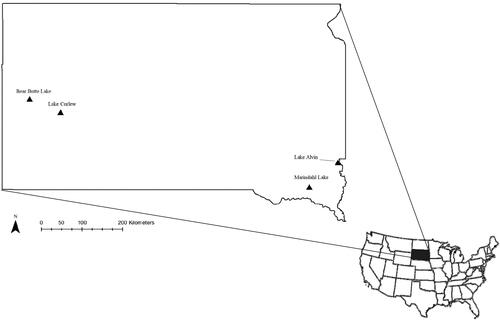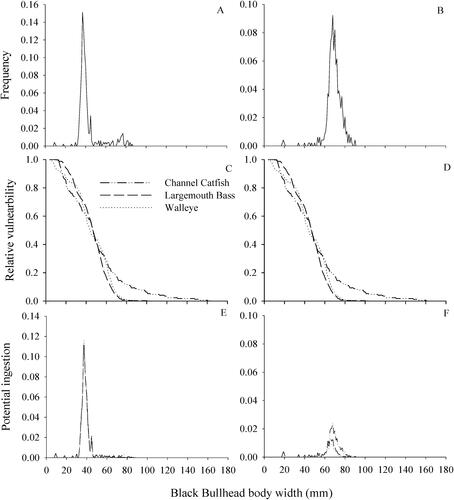Figures & data
Figure 1. Locations of the four small reservoirs in South Dakota, USA used in this study. Bear Butte and Curlew Lakes were sampled in 2017. Lakes Alvin and Marindahl were sampled in 2018.

Table 1. Surface area and mean and maximum depths of the four small impoundments sampled for this study. Specific locations of all four waterbodies are shown in .
Table 2. Length ranges used to classify juvenile and adult channel catfish, largemouth bass, and walleye captured in this study. Categories are based on previous studies documenting the total lengths of predators when they reach sexual maturity.
Figure 2. Frequency of occurrences of gape widths for three different predators collected from four South Dakota small impoundments. Predator species included channel catfish (top panel; n = 170), largemouth bass (middle panel; n = 590), and walleye (bottom panel; n = 652).

Figure 3. Comparison of body depths of black bullheads without (A) and with the dorsal spine extended (B) and the relative vulnerability to potential ingestion (C and D) by three predators common to four South Dakota small impoundments sampled in this study. Measurements of black bullhead depths and predator gape widths were based on fish collected across all four reservoirs combined.

Figure 4. Comparison of body widths of black bullheads without (A) and with pectoral spines extended (B) and the relative vulnerability to potential ingestion (C and D) by three predators common to four South Dakota small impoundments sampled in this study. Measurements of black bullhead depths and predator gape widths were based on fish collected across all four reservoirs combined.

Table 3. Frequency of occurrence (Oi; %) of Black Bullhead prey items in both adult and juvenile predators across four South Dakota impoundments by month. Numbers in parentheses indicate the number of fish with food in their stomachs that were examined in that lake during that time period. Blanks indicate that no predators of that species and age category were collected from that lake in that month. Zeros indicate that predators were collected during that month but none consumed any black bullhead.
Data availability statement
The data that support the findings of this study are openly available in Mendeley Data at https://data.mendeley.com/datasets/g53r4hf79x/1 (doi: 10.17632/g53r4hf79x.1).
